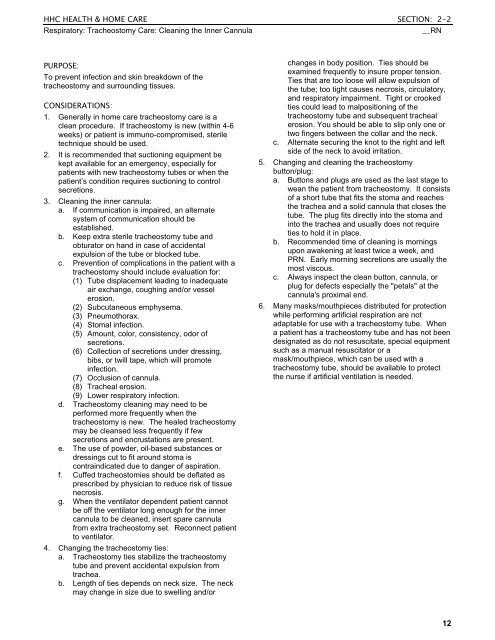HHC Health & Home Care Clinical Policy And
HHC Health & Home Care Clinical Policy And
HHC Health & Home Care Clinical Policy And
Create successful ePaper yourself
Turn your PDF publications into a flip-book with our unique Google optimized e-Paper software.
<strong>HHC</strong> HEALTH & HOME CARE SECTION: 2-2<br />
Respiratory: Tracheostomy <strong>Care</strong>: Cleaning the Inner Cannula __RN<br />
PURPOSE:<br />
To prevent infection and skin breakdown of the<br />
tracheostomy and surrounding tissues.<br />
CONSIDERATIONS:<br />
1. Generally in home care tracheostomy care is a<br />
clean procedure. If tracheostomy is new (within 4-6<br />
weeks) or patient is immuno-compromised, sterile<br />
technique should be used.<br />
2. It is recommended that suctioning equipment be<br />
kept available for an emergency, especially for<br />
patients with new tracheostomy tubes or when the<br />
patient’s condition requires suctioning to control<br />
secretions.<br />
3. Cleaning the inner cannula:<br />
a. If communication is impaired, an alternate<br />
system of communication should be<br />
established.<br />
b. Keep extra sterile tracheostomy tube and<br />
obturator on hand in case of accidental<br />
expulsion of the tube or blocked tube.<br />
c. Prevention of complications in the patient with a<br />
tracheostomy should include evaluation for:<br />
(1) Tube displacement leading to inadequate<br />
air exchange, coughing and/or vessel<br />
erosion.<br />
(2) Subcutaneous emphysema.<br />
(3) Pneumothorax.<br />
(4) Stomal infection.<br />
(5) Amount, color, consistency, odor of<br />
secretions.<br />
(6) Collection of secretions under dressing,<br />
bibs, or twill tape, which will promote<br />
infection.<br />
(7) Occlusion of cannula.<br />
(8) Tracheal erosion.<br />
(9) Lower respiratory infection.<br />
d. Tracheostomy cleaning may need to be<br />
performed more frequently when the<br />
tracheostomy is new. The healed tracheostomy<br />
may be cleansed less frequently if few<br />
secretions and encrustations are present.<br />
e. The use of powder, oil-based substances or<br />
dressings cut to fit around stoma is<br />
contraindicated due to danger of aspiration.<br />
f. Cuffed tracheostomies should be deflated as<br />
prescribed by physician to reduce risk of tissue<br />
necrosis.<br />
g. When the ventilator dependent patient cannot<br />
be off the ventilator long enough for the inner<br />
cannula to be cleaned, insert spare cannula<br />
from extra tracheostomy set. Reconnect patient<br />
to ventilator.<br />
4. Changing the tracheostomy ties:<br />
a. Tracheostomy ties stabilize the tracheostomy<br />
tube and prevent accidental expulsion from<br />
trachea.<br />
b. Length of ties depends on neck size. The neck<br />
may change in size due to swelling and/or<br />
changes in body position. Ties should be<br />
examined frequently to insure proper tension.<br />
Ties that are too loose will allow expulsion of<br />
the tube; too tight causes necrosis, circulatory,<br />
and respiratory impairment. Tight or crooked<br />
ties could lead to malpositioning of the<br />
tracheostomy tube and subsequent tracheal<br />
erosion. You should be able to slip only one or<br />
two fingers between the collar and the neck.<br />
c. Alternate securing the knot to the right and left<br />
side of the neck to avoid irritation.<br />
5. Changing and cleaning the tracheostomy<br />
button/plug:<br />
a. Buttons and plugs are used as the last stage to<br />
wean the patient from tracheostomy. It consists<br />
of a short tube that fits the stoma and reaches<br />
the trachea and a solid cannula that closes the<br />
tube. The plug fits directly into the stoma and<br />
into the trachea and usually does not require<br />
ties to hold it in place.<br />
b. Recommended time of cleaning is mornings<br />
upon awakening at least twice a week, and<br />
PRN. Early morning secretions are usually the<br />
most viscous.<br />
c. Always inspect the clean button, cannula, or<br />
plug for defects especially the "petals" at the<br />
cannula's proximal end.<br />
6. Many masks/mouthpieces distributed for protection<br />
while performing artificial respiration are not<br />
adaptable for use with a tracheostomy tube. When<br />
a patient has a tracheostomy tube and has not been<br />
designated as do not resuscitate, special equipment<br />
such as a manual resuscitator or a<br />
mask/mouthpiece, which can be used with a<br />
tracheostomy tube, should be available to protect<br />
the nurse if artificial ventilation is needed.<br />
12







